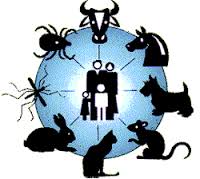What are zoonotic diseases?
Zoonotic disease is any contagious disease that can pass between humans and animals. According to the CDC, these diseases are caused by bacteria, viruses, parasites, or fungi that are carried by animals or insects.
What are some common zoonotic disease that I should be concerned about?
What are some common zoonotic disease that I should be concerned about?
- Baylisascaris is a common large roundworm of raccoons. This parasite can infect a variety of animals including dogs. Human infection, though rare, can be severe if the parasites invade the eye, organs, or brain. Possible complications from infection include central nervous system disease, blindness, coma, and death. Children are at greatest risk of infection because of poor hygienic habits, and propensity for placing soil and other materials into the mouth.
- Toxoascaris canis is a common roundworm of dogs and cats. This parasite can cause significant clinical disease including internal organ damage and blindness in people. Others may contract the parasite and show no symptoms. Humans contract Toxocara by accidentally consuming infected dirt or sand, therefore children are at a greater risk of ingesting parasite eggs. Pet's stool samples should be checked every 6-12 months, and monthly preventative such as Sentinel should be given year round to prevent and control roundworm infection.
- Salmonella bacteria are commonly shed in the feces of reptiles (turtles, snakes, lizards) and amphibians (frogs, toads). The bacteria can easily infect the animal's body, water, and environment, spreading it to people. Small children are especially susceptible to Salmonella infection, therefore reptiles and amphibians should not be kept as pets in homes or in class rooms. Symptoms include fever, severe diarrhea, and abdominal cramps. Systemic infections and death are more likely in children and the immunocompromised
- Rabies is a fatal viral infection that effects all mammals. The virus damages the central nervous system and almost always ends in death. Rabies is most commonly spread by the bite of an infected animal carrying the virus in its saliva. Signs of rabies in animals include unusual changes in behavior, stumbling, drooling, and restlessness. In most human cases, the person is infected through a bite wound from an infected animals. Clinical signs may take 1-3 months to develop and include difficulty swallowing, fever, headache, confusion, and itching at the location of the bite. Never pick up injured or sick wildlife. If you feel that you may have been exposed to an animal infected with rabies, contact your health care provider immediately.
- Tapeworms (Dipylidium) are common parasites of dogs and cats and appear as 'grains of rice' stuck around the animal's tail and rear end. Pets contract tapeworms by eating infected fleas either on themselves or on prey animals. Though rare, it is possible for humans to become infected with tapeworms if they too swallow an infected flea. Most reported cases involve children. Effective flea control is key to preventing a flea infestation and controlling tapeworm infection.
- Leptospirosis is caused by a bacteria that can cause damage to kidneys, liver, and other organs of people and animals. The bacteria is spread through the urine of infected animals (mice, rats, canines, etc.) and can survive in water or soil for several weeks to months. Animals and people become infected when they come into contact with the contaminated water or soil. The bacteria can enter the body through cuts and through the mucous membranes (eyes, nose, or mouth), by drinking contaminated water, or breathing in infected aerosolized particles. Humans can also be exposed through direct contact with contaminated animal urine. Vaccination is available for dogs, pigs, and cattle which helps to prevent disease severity, but may not prevent infection.
This is not a comprehensive list of zoonotic diseases. Please refer to the CDC or The Center for Food Security & Public Health for more information.

